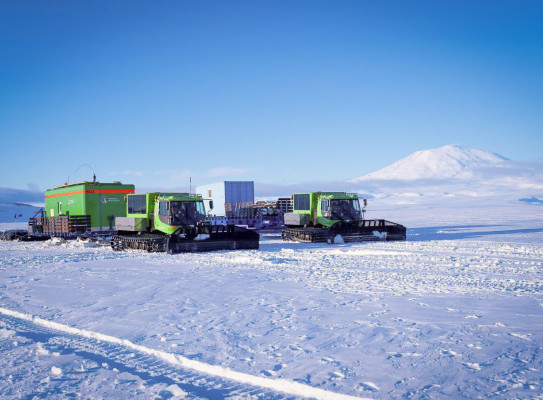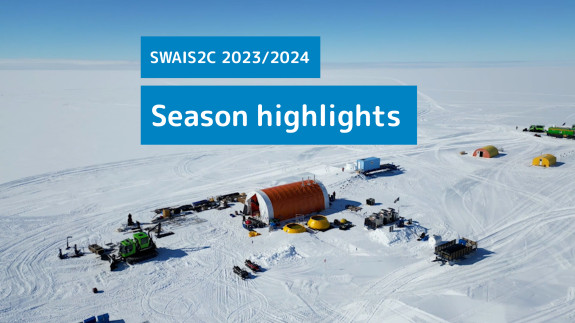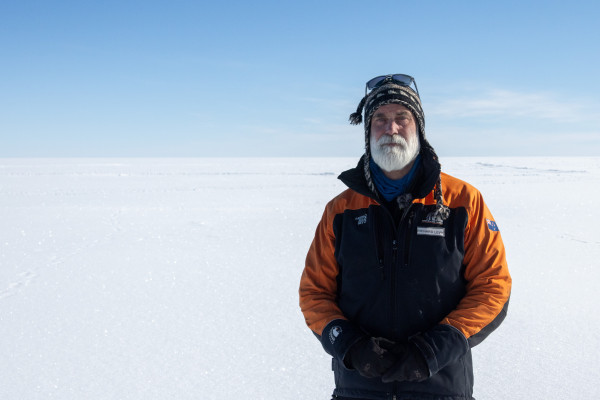International team launch second attempt to drill deep for Antarctic climate clues

Kiwi climate researchers are part of an ambitious mission to recover critical geological records to help forecast future sea-level rise. The first team members have embarked on a 1128 km journey across the Ross Ice Shelf to set up camp on the edge of the West Antarctic Ice Sheet.
The vast West Antarctic Ice Sheet holds enough ice to raise sea level by 4-5 m if it melts completely. Research has found a collapse might be inevitable for some parts of the West Antarctic Ice Sheet, such as the area around the ‘Doomsday Glacier’ (Thwaites Glacier) in the Amundsen Sea, due to the presence of warm water next to it. In contrast, water underneath the large Ross Ice Shelf remains cold. The Ross Ice Shelf serves as a stabilising buttress to the inland ice of other areas of the West Antarctic Ice Sheet. But we lack direct evidence if, and when we will lose it.
Understanding what temperature will trigger unavoidable melt of the Ross Ice Shelf, and the subsequent collapse of the West Antarctic Ice Sheet, is critical for all of humanity. This is the challenge driving the scientists, drillers and Antarctic field specialists from 13 countries to come together as part of the SWAIS2C(external link) (Sensitivity of the West Antarctic Ice Sheet to 2°C) project, and why the “on-ice” team of 27 will camp at the KIS3 drilling site this Antarctic summer.
The team is seeking insights contained in sediment layered in the seafloor under the Ross Ice Shelf. To obtain this record they must melt a hole through around 580 m of the ice shelf, pass through a 55 m ocean cavity, and use a custom-designed drilling system to retrieve a sediment core from up to 200 m deep into the seabed.
This is no easy task – something the team knows all too well. Due to technical difficulties, their efforts to do so last year were scuppered after reaching the seafloor.
“We were making the first ever attempt to obtain a core this deep so far from a base and so close to the centre of the West Antarctic Ice Sheet,” says Richard Levy, SWAIS2C Co-chief Scientist, from GNS Science and Te Herenga Waka – Victoria University of Wellington.
“Cutting-edge Antarctic frontier science is challenging, and we learned valuable lessons."
We’re heading back this year to finish what we started, with an even greater sense of urgency – the climate warning signs are only getting louder.

“Since our last deployment we’ve seen global temperatures reach record highs across the world. Last year, the average increase in Earth’s annual surface temperature exceeded the 1.5°C target of the Paris Agreement for the first time since we started routinely measuring temperature with instruments. While this increase may be temporary, we are well on track to permanently cross this threshold in the next 5 to 10 years,” says Levy.
The coveted core is expected to reach back hundreds of thousands of years, potentially millions of years. Such a record would include the last interglacial period 125,000 years ago, when Earth was around 1.5°C warmer than pre-industrial temperatures – similar to the temperatures we’ve approached this year due to human-caused climate change.
The sequence of rocks and mud will reveal how the West Antarctic Ice Sheet behaved during this past time of warmer temperature. If the researchers find marine algae, indicating open ocean conditions, it’s likely the ice sheet retreated.
The team calls SWAIS2C “the discovery for our lifetime” and hopes the results will guide plans to adapt to unavoidable sea-level rise, while amplifying the imperative to mitigate global greenhouse gas emissions.
“Retrieving this sample from such a remote location will help us build a clearer picture of how the West Antarctic Ice Sheet will respond to future warming, which parts will melt first and which parts will remain. We’re using the past to help us prepare for our future,” says Prof Tina van de Flierdt, SWAIS2C Co-chief Scientist, from Imperial College London.

The mission for ‘the discovery for our lifetime’ begins with an extreme polar road trip
Drilling at a deep-field research camp so far from a research station requires a large amount of gear, both for the drilling itself and the operations of the camp. Antarctica New Zealand are leading the logistical support for the project.
A team departed Scott Base on 1 November in a convoy of PistenBully polar vehicles, towing sleds laden with fuel, equipment, and provisions to sustain the camp for the approximately 8-week season. Their 1128 km journey is expected to take 15 days over the Ross Ice Shelf, the largest on Earth, and requires a Ground Penetrating Radar to help them detect and avoid treacherous crevasses.
Once they’ve arrived at KIS3 they’ll create a runway on the ice for ski-equipped aircraft, allowing the drillers and scientists to fly in (860 km ‘as the crow flies’) later in November.
Antarctica New Zealand’s Acting Chief Executive, Prof Jordy Hendrikx, said quantifying Antarctica’s contribution to sea level rise was a strategic priority for New Zealand, an island nation dominated by coastal homes and infrastructure.
"This project underscores the importance of international collaboration in addressing the critical questions surrounding our planet's future, with New Zealand playing a key role. Despite our size, we’ve built a strong reputation for field operations, enabling cutting-edge science through experience, robust planning and efficiency. We are proud to support this vital work, ultimately aiming to protect our own and global communities from the impacts of rising sea levels."
-
About the SWAIS2C project
- KIS3 is a drilling site on the Kamb Ice Stream of Antarctica’s Siple Coast, the grounding zone of the West Antarctic Ice Sheet where the ice sheet begins to float as the Ross Ice Shelf.
- More than 130 people from around 50 international research organisations are collaborating on the SWAIS2C project. SWAIS2C brings together researchers from New Zealand, the United States, Germany, Australia, Italy, Japan, Spain, Republic of Korea, the Netherlands, and the United Kingdom.
- Geological reconstructions from around the world indicate that during the last interglacial period 125,000 years ago, when Earth’s average surface temperature was 1 to 1.5°C warmer than pre-industrial, sea levels were ~6 m higher than today. This suggests that parts or all of the West Antarctic Ice Sheet may have collapsed, highlighting a potential sensitivity to temperatures that we have already reached, and will certainly experience in the coming decade. SWAIS2C aims to obtain robust, direct evidence for potential ice collapse under different environmental conditions.
- Approximately 680 million people around the world live in low-lying coastal regions and are exposed to hazards and impacts due to sea level rise.
-
SWAIS2C management and funding
The SWAIS2C (external link)Project Manager is GNS Science and the Drilling Services Provider is Te Herenga Waka—Victoria University of Wellington(external link). Logistical support comes from Antarctica New Zealand(external link) (K862A-2324, K862A-2425) in collaboration with the United States Antarctic Program(external link). Drilling is partly funded and supported by the ICDP(external link). Significant additional funding and in-kind contributions have been provided by the Natural Environment Research Council(external link), Alfred-Wegener-Institute Helmholtz Centre for Polar and Marine Research(external link), Federal Institute for Geosciences and Natural Resources(external link), National Science Foundation(external link) (NSF-2035029, 2034719, 2034883, 2034990, 2035035, and 2035138), German Research Foundation(external link) (grants KU 4292/1-1, MU 3670/3-1, KL 3314/4-1), Istituto Nazionale di Geofisica e Vulcanologia(external link), Korea Polar Research Institute(external link), National Institute of Polar Research(external link), Antarctic Science Platform(external link) (ANTA1801), LIAG Institute for Applied Geophysics(external link), AuScope(external link), and the Australian and New Zealand IODP Consortium(external link). This project is the first in Antarctica for the International Continental Scientific Drilling Project (ICDP), and follows on from other successful international Antarctic research programmes such as ANDRILL.